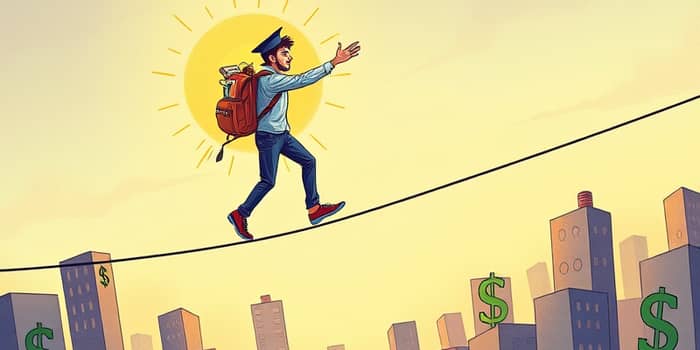For millions of Americans, the dream of higher education carries a hefty financial burden. In 2025, outstanding student loans loom larger than ever, touching every corner of the country and every stage of life. But with the right approach, determination, and knowledge, borrowers can navigate this challenge, regain control of their finances, and emerge stronger.
This article offers a comprehensive, step-by-step guide to understanding the current landscape of student debt, choosing the most effective repayment strategies, and building a plan that fits your goals and circumstances. Whether you’re fresh out of college, midway through repayment, or seeking forgiveness options, you’ll find actionable insights and encouragement to stay on track.
The Weight of Student Loan Debt in 2025
Student loan debt has soared to unprecedented levels. As of mid-2025, an estimated 42.3 million Americans carry federal student loan balances. Combined with private loans, the total outstanding student loan debt has ballooned to $1.81 trillion, with $1.67 trillion held in federal programs.
On average, borrowers leave campus owing $39,075 in federal loans and nearly $42,673 when private debt is included. Graduates from public universities owe an average of $31,960, and states like Georgia, Mississippi, and Virginia have some of the highest per-capita loan balances. These figures underscore the scale of the challenge for individuals and for the economy as a whole.
Delinquency rates have climbed sharply. In Q2 of 2025, 31% of federal student loan borrowers with active payments were at least 90 days past due—nearly triple the rate in early 2020. Defaults not only damage credit scores by an average of 60 points but can also trigger wage garnishment, tax refund seizures, and long-term financial hardship.
Proven Repayment Strategies
Developing a plan starts with selecting the right tactics. No single approach fits everyone, but these methods form the backbone of an effective repayment journey:
- Pay More Than the Minimum – Making extra payments, rounding up your monthly amount, or applying occasional lump sums can substantially reduce your principal and cut total interest costs.
- Automate Payments – Enrolling in automatic payments avoids missed deadlines and often qualifies you for a 0.25% rate reduction with your servicer.
- Biweekly Payments – Splitting your monthly payment in half and paying every two weeks results in one extra payment per year, shortening your repayment horizon and reducing interest.
- Avalanche vs. Snowball Method – The avalanche method targets high-interest loans first for maximum savings, while the snowball method pays off smaller balances quickly to build momentum.
- Refinancing and Consolidation – Refinancing can lower your rate if you have strong credit, whereas federal consolidation simplifies multiple loans without necessarily reducing interest.
Choosing between the avalanche and snowball approaches often comes down to personal psychology versus pure math. If quick wins keep you motivated, the snowball method may be best. If you’re focused on long-term savings, avalanche offers the greatest interest reduction.
Comparing Avalanche and Snowball Methods
Selecting the Right Path for You
Your income, debt ratio, and long-term goals should guide your repayment strategy. Three broad paths exist:
1. Aggressive Payoff: If you have a low debt-to-income ratio, aim to pay more than the minimum. This path minimizes total interest and frees you from debt sooner.
2. Forgiveness-Focused: For borrowers with high balances and modest income, making only minimum payments under an Income-Driven Repayment plan preserves eligibility for Public Service Loan Forgiveness (PSLF) or IDR forgiveness after 20–25 years. Remember: track progress and maintain eligibility.
3. Sustainable Minimum: If neither rapid payoff nor forgiveness is within reach, select the plan with the lowest monthly payment and maintain consistency. Staying current, even on small amounts, protects your credit and avoids default.
Federal Repayment Plans
- Standard (10-year) Repayment – Fixed payments; least interest if you pay on schedule.
- Graduated Repayment – Lower initial payments that rise every two years; ideal for expected income growth.
- Income-Driven Repayment – Payments set as a percentage of discretionary income; balances may be forgiven after 20–25 years.
Loan Forgiveness Options
- Public Service Loan Forgiveness (PSLF) – 120 qualifying payments for public or nonprofit employees leads to full forgiveness.
- Teacher Loan Forgiveness – Up to $17,500 forgiven after five years in eligible low-income schools.
- IDR Forgiveness – Remaining balance forgiven after 20–25 years in an Income-Driven plan.
Building Financial Resilience Beyond Repayment
Repayment is only one milestone on your financial journey. To cultivate lasting stability, consider these practices:
First, create an emergency fund of three to six months’ living expenses. This cushion prevents new debt when unexpected costs arise. Second, pay down high-interest consumer debts—like credit cards—before funneling additional resources into student loans.
Finally, invest in your future. Even small contributions to retirement accounts can grow significantly over time, providing freedom to make life choices without feeling tethered to loan obligations. With each milestone—eliminating a loan, reaching a savings goal—you’ll build confidence and momentum.
While the climb may be steep, every dollar chipped away, every payment made on time, brings you closer to financial freedom. Armed with knowledge, persistence, and a tailored strategy, you can transform your student debt from an overwhelming burden into a conquered challenge and a stepping stone toward a brighter future.
References
- https://www.bestcolleges.com/research/average-student-loan-debt/
- https://landmarkcu.com/blog/pay-off-student-loans-faster/
- https://newsroom.transunion.com/june-2025-student-loan-update/
- https://www.ameriprise.com/financial-goals-priorities/personal-finance/how-to-manage-student-loan-debt
- https://educationdata.org/student-loan-debt-statistics
- https://www.salliemae.com/blog/debt-snowball-vs-avalanche/
- https://studentaid.gov/data-center/student/portfolio
- https://www.edcapny.org/resources-for-borrowers/student-loan-repayment-strategies-plans/










